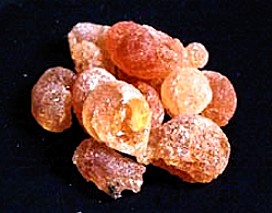Lessico
Gomma ammoniaco
Dorema ammoniacum
La gomma
ammoniaco è il succo che scola dal Dorema ammoniacum e da varie specie
di ferule![]() . Dorema – forse dal greco δώρημα = dono –
è un genere di piante della famiglia Ombrellifere, con 4 specie: sono grandi
erbe perenni simili alle ferule, che vivono nelle regioni subdesertiche della
Persia. Esse forniscono - soprattutto il Dorema ammoniacum -
la gommoresina detta appunto gomma ammoniaco.
. Dorema – forse dal greco δώρημα = dono –
è un genere di piante della famiglia Ombrellifere, con 4 specie: sono grandi
erbe perenni simili alle ferule, che vivono nelle regioni subdesertiche della
Persia. Esse forniscono - soprattutto il Dorema ammoniacum -
la gommoresina detta appunto gomma ammoniaco.

Ammoniacum, or gum ammoniac, is a gum-resin exuded from the stem of a perennial herb (Dorema ammoniacum), natural order Umbelliferae. The plant grows to the height of 8 or 9 ft., and its whole stem is pervaded with a milky juice, which oozes out on an incision being made at any part. This juice quickly hardens into round tears, forming the "tear ammoniacum" of commerce.
"Lump ammoniacum," the other form in which the substance is met with, consists of aggregations of tears, frequently incorporating fragments of the plant itself, as well as other foreign bodies.
Ammoniacum has a faintly fetid, unpleasant odor, which becomes more distinct on heating; externally it possesses a reddish-yellow appearance, and when the tears or lumps are freshly fractured they exhibit a waxy luster.
It is
chiefly collected in central Persia, and comes to the European market by way
of Bombay. Ammoniacum is closely related to asafoetida![]() and
galbanum
and
galbanum![]() (from
which, however, it differs in yielding no umbelliferone) both in regard to the
plant which yields it and its therapeutical effects. Internally it is used in
conjunction with squills
(from
which, however, it differs in yielding no umbelliferone) both in regard to the
plant which yields it and its therapeutical effects. Internally it is used in
conjunction with squills![]() (Urginea
maritima) in bronchial affections; and in asthma and chronic colds it is
found useful, but it has no advantages over a number of other substances of
more constant and active properties (Sir Thomas Fraser). Only the "tear
ammoniacum" is official. African ammoniacum is the product of a plant
said to be Ferula tingitana, which grows in North Africa; it is a dark
colored gum-resin, possessed of a very weak odor and a persistent acrid taste.
(Urginea
maritima) in bronchial affections; and in asthma and chronic colds it is
found useful, but it has no advantages over a number of other substances of
more constant and active properties (Sir Thomas Fraser). Only the "tear
ammoniacum" is official. African ammoniacum is the product of a plant
said to be Ferula tingitana, which grows in North Africa; it is a dark
colored gum-resin, possessed of a very weak odor and a persistent acrid taste.
Dorema ammoniacum
Description: Natural Order, Umbelliferae. A native of Persia, India, and other Oriental countries. It is a biennial, attaining the height of six or seven feet, and abounding in a somewhat milky juice. This juice is gathered in the spring time, from incisions made in the roots, after the manner of asafoetida. It is a gum resin, and comes to market in the form of tears consolidated into rough masses; yellowish without, whitish within, compact and brittle. At a moderate heat, it softens without melting; and will burn with a white flame and much smoke. It is partly soluble in water, with which it forms a milky emulsion; and acts as other resins with alcohol.
Properties and Uses: Stimulant, with moderate relaxing powers, rather diffusive in its action, chiefly influencing the mucous membranes. It should not be used in any case where inflammation is present, but is suited to relaxed and atonic conditions. It is employed in old coughs with pulmonic debility and excessive mucous secretion; and sometimes in leucorrhea, and amenorrhea under similar circumstances. It has been found of use in asthmatic and catarrhal affections under the same conditions. It gently promotes the flow of urine; and a warm preparation will act moderately upon the skin. It is not an agent to be relied upon largely; but makes an excellent adjunct to stronger and less diffusive articles. From ten to twenty grains may be given at a dose, three times a day; and though it may be used as a pill, the form of emulsion is better. The emulsion is formed by triturating two drachms of the gum with half a pint of water; and one to two tablespoonfuls of this may be given as a dose.
www.henriettesherbal.com